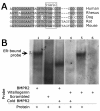BMPR2 expression is suppressed by signaling through the estrogen receptor
- PMID: 22348410
- PMCID: PMC3310853
- DOI: 10.1186/2042-6410-3-6
BMPR2 expression is suppressed by signaling through the estrogen receptor
Abstract
Background: Studies in multiple organ systems have shown cross-talk between signaling through the bone morphogenetic protein receptor type 2 (BMPR2) and estrogen pathways. In humans, pulmonary arterial hypertension (PAH) has a female predominance, and is associated with decreased BMPR2 expression. The goal of this study was to determine if estrogens suppress BMPR2 expression.
Methods: A variety of techniques were utilized across several model platforms to evaluate the relationship between estrogens and BMPR2 gene expression. We used quantitative RT-PCR, gel mobility shift, and luciferase activity assays in human samples, live mice, and cell culture.
Results: BMPR2 expression is reduced in lymphocytes from female patients compared with male patients, and in whole lungs from female mice compared with male mice. There is an evolutionarily conserved estrogen receptor binding site in the BMPR2 promoter, which binds estrogen receptor by gel-shift assay. Increased exogenous estrogen decreases BMPR2 expression in cell culture, particularly when induced to proliferate. Transfection of increasing quantities of estrogen receptor alpha correlates strongly with decreasing expression of BMPR2.
Conclusions: BMPR2 gene expression is reduced in females compared to males in live humans and in mice, likely through direct estrogen receptor alpha binding to the BMPR2 promoter. This reduced BMPR2 expression may contribute to the increased prevalence of PAH in females.
Figures





References
-
- Beppu H, Ichinose F, Kawai N, Jones RC, Yu PB, Zapol WM, Miyazono K, Li E, Bloch KD. BMPR-II heterozygous mice have mild pulmonary hypertension and an impaired pulmonary vascular remodeling response to prolonged hypoxia. Am J Physiol Lung Cell Mol Physiol. 2004;287:L1241–L1247. doi: 10.1152/ajplung.00239.2004. - DOI - PubMed
Grants and funding
LinkOut - more resources
Full Text Sources
Miscellaneous

